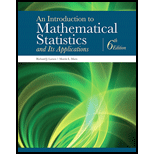
Concept explainers
Let A and B be any two
(a) the complement of their intersection is the union of their complements:
(b) the complement of their union is the intersection of their complements:
(These two results are known as DeMorgan's laws.)
Want to see the full answer?
Check out a sample textbook solution
Chapter 2 Solutions
An Introduction to Mathematical Statistics and Its Applications (6th Edition)
- T1.2 A person entering a university building is a student (S), faculty (F), or staff (W). We observe three successive persons entering the building. a) List all outcomes in the event A that exactly two are students. b) List all outcomes in the event B that the third person is a facultyarrow_forwarda. Find the probability that the device A functions but the device B does not. b. Find the probability that the device A or the device B or both function. c. Find the probability that the circuit operates. d. It is known that the circuit is operating, find the probability that device A is functional.arrow_forwardA dietitian surveyed the patients who visited a clinic on a certain day about their eating habits and found that 24 ate vegetables, 20 ate chicken, and 15 ate fish. The dietitian also found that 14 ate both vegetables and chicken, 13 ate both vegetables and fish, 11 ate both chicken and fish, and 10 ate all three. Which of the following Venn diagrams best represents the survey results? (V, C, and F are labels for vegetables, chicken, and fish, respectively.) O y 24 4 20 3 10 15 20 12 14 4 10 3 10 5 A 2:1. 5/14 ÉTS) PRAXIS. 5161 Mathe PRAXIS. ecan be used to give a geometric proof of whrch of the iclowagdnarrow_forward
- Suppose that vehicles taking a particular freeway exit can turn right (R), turn left (L), or go straight (S). Consider observing the direction for each of three successive vehicles. (Enter your answers in set notation. Enter EMPTY or ∅ for the empty set.) (a) List all outcomes in the event A that all three vehicles go in the same direction.A = (b) List all outcomes in the event B that all three vehicles take different directions.B = (c) List all outcomes in the event C that exactly two of the three vehicles turn right.C = (d) List all outcomes in the event D that exactly two vehicles go in the same direction.D = (e) List outcomes in D'.D' = List outcomes in C ∪ D.C ∪ D = List outcomes in C ∩ D.C ∩ D =arrow_forwardlet A and B be setsarrow_forwardDraw a Venn diagram that represents (S ∪ T) − (S ∩ T).arrow_forward
- Let A= {5, 6, 7, 8}, Let R: A-> A and S: A-> A. Let R= {(5, 6) (6, 8) (7, 6) (8, 7)} and S= {(5, 5) (6, 8) (7, 5) (8, 8)}. Find the answers for the following and draw the arrow diagram for each result. (a) R o S (b) S o Rarrow_forwardPlease help me?arrow_forwardFor the joint probability distribution below, t Y= 1 2 0 1/6 1 1/3 1/6 2 1/12 1/12 1/6 X=arrow_forward
